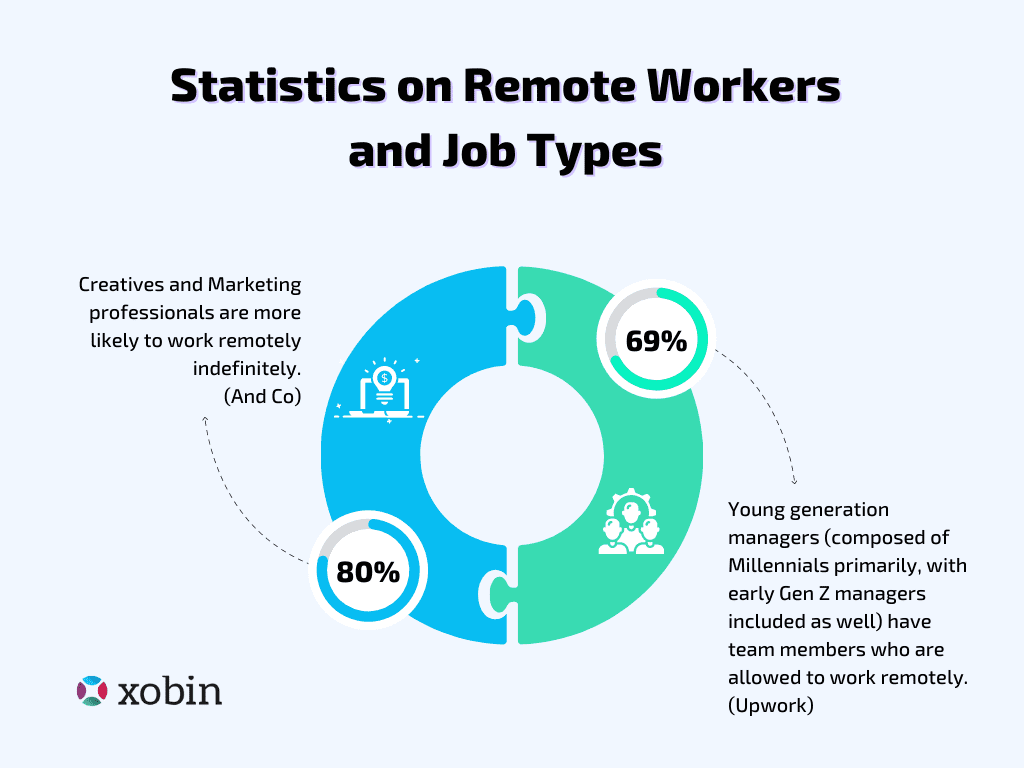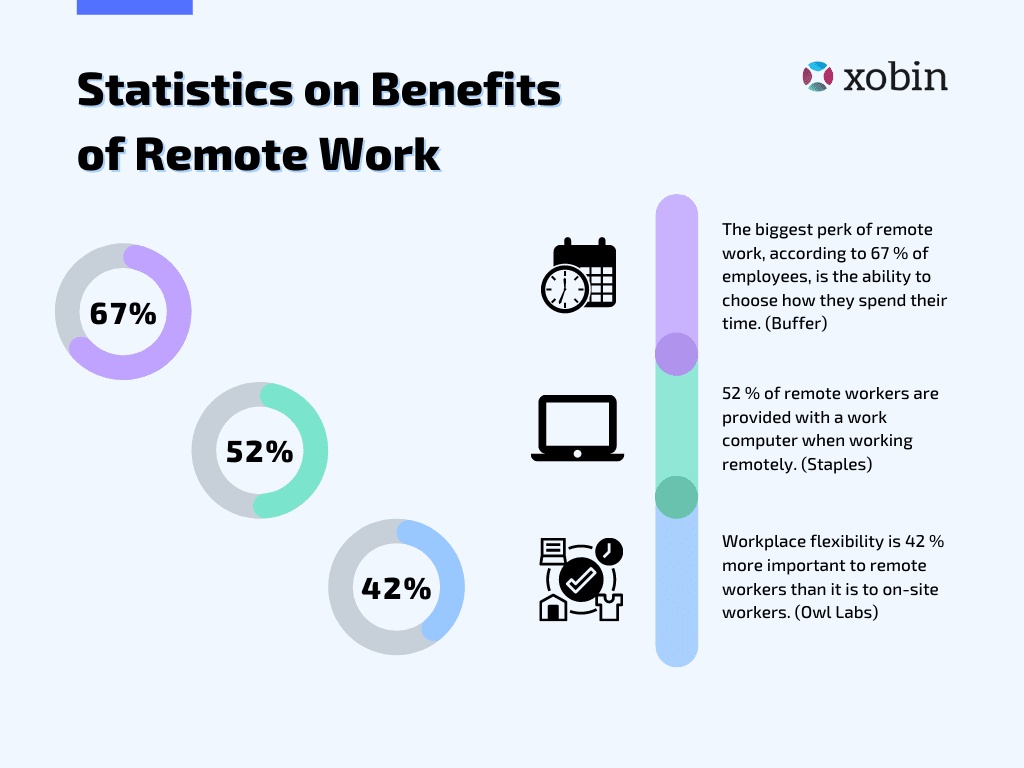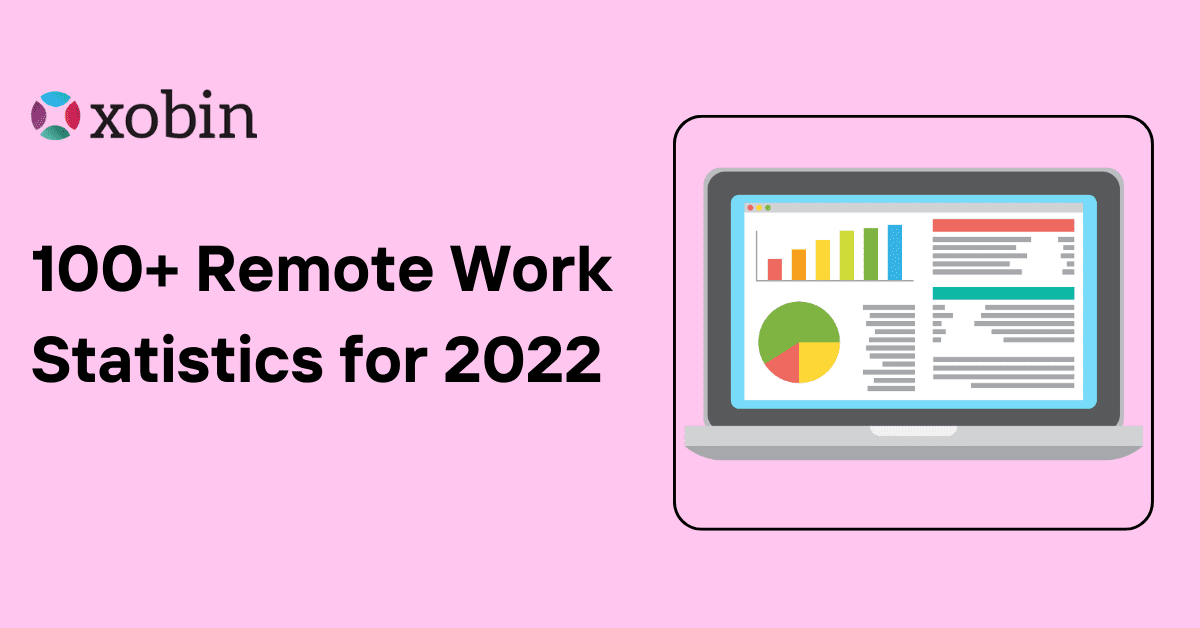Remote work has truly arrived. Although it took time for people to adjust to this new way of functioning, it has now been embraced by both employers and employees. To ensure efficiency in remote hiring, companies rely on pre-employment testing to assess candidates effectively. Analyzing remote work statistics helps understand how this shift is shaping the workforce.
Table of Contents
This collection of remote work statistics tries to dive deep to answer a few questions :
What are the quantifiable benefits for remote workers?
What are the quantifiable benefits for organizations and businesses?
How is remote work started to grow in the future?
Typically challenges in remote working?
Keep reading for more interesting remote work statistics
Future of Remote Work
By 2024, remote workers will account for 32% of all employees worldwide. (Source: Gartner)
In the next five years, 40.7 million American professionals will be entirely remote, up from 22.9 percent in November 2020. (Source: Upwork)
The number of people who work remotely on a weekly basis has approximately increased by 400% since 2010. (Source: GetApp)
By the year 2028, 73% of all teams will have remote workers. (Source: Upwork)
82% of people know someone who works remotely. (Source: FlexJobs)
Productivity in remote work has increased by 47%. (Source: Credit Summit)
66% of knowledge workers believe the traditional office setting will be obsolete by 2030. (Source: Zapier)
62% of companies globally currently have a remote working policy. (Source: IWG)
By 2030, the US could see an economic boost of $4.5 trillion annually as a result of remote working, while China and India could gain respectively $1.4 trillion and $376 billion extra annually. (Source: IWG)
91% of Asia’s Top 200 Occupiers are considering using flexible workspace and 56% are already using it. (Source: IWG)
Whether 100% work-from-home or hybrid—the majority of business leaders (85%) agree that remote work is the future. (Life And My Finances)
42% of remote workers plan to work remotely more frequently than they currently do in the next 5 years, and more than half of on-site workers want to start working remotely. (Source: Owl Labs)
40% of remote workers said that a part of their team is full-time remote. (Source: Buffer)
93% of remote workers reported that their companies make an effort to make them feel included in the company culture. (Source: Coolpo)
97% of workers would like to work remotely at least some of the time for the rest of their careers. (Source: Buffer)
Statistics on Remote Workers and Job Types
It’s true that remote work is more suited for certain job roles. typically associated with technology and digital marketing roles, such as web development, web design, and content creation. However, healthcare is actually the industry with the most remote employees. It just comes to show that, no matter which area you work in, it’s worth always looking for remote opportunities.

80% of Creatives and Marketing professionals are more likely to work remotely indefinitely. (Source: And Co)
Senior executives and above say they work remotely at least once per week 34% more than those in lower positions. (Source: Owl Labs)
69% of young generation managers (composed of Millennials primarily, with early Gen Z managers included as well) have team members who are allowed to work remotely. (Source: Upwork)
Remote Work Statistics on Job Retention
- 44 percent know at least one individual who has quit or plans to quit their job due to in-person work requirements. (Source: FlexJobs)
- 73 percent of companies fear that post-pandemic remote work expectations will alter the competitive landscape for attracting and maintaining talent. (Source: Payscale)
- 77% of firms globally report that they have introduced flexible working policies to attract and retain top talent. (Source: IWG)
- Remote workers say they are likely to stay in their current job for the next 5 years 13% more than onsite workers. (Source: Owl Labs)
- 58% of workers stated they would “definitely” look for a new job if they were unable to continue working remotely in their current employment. (Source: FlexJobs)
- 81% of remote workers agree that the ability to work remotely would make them more likely to recommend their company to a friend. (Source: Owl Labs)
- 74% of remote workers agree that the ability to work remotely would make them less likely to leave their employer. (Source: Owl Labs)
- 71% of remote workers agree that the ability to work remotely would make them more likely to choose one employer over another in their next job. (Source: Owl Labs)
- 97% of workers would recommend remote work to coworkers, friends, or family members. (Source: Buffer)
- 30% of employees have reported leaving a job because it did not offer remote work options. (Source: FlexJobs)
- 52% of employees have tried to negotiate flexible work arrangements with their employers. (Source: FlexJobs)
Statistics on Benefits of Remote Work

- The biggest perk of remote work, according to 67 percent of employees, is the ability to choose how they spend their time. (Source: Buffer)
- Parental leave is 23% more important to remote workers than it is to on-site workers. (Source: Owl Labs)
- 52% of remote workers are provided with a work computer when working remotely. (Source: Staples)
- Workplace flexibility is 42% more important to remote workers than it is to on-site workers. (Source: Owl Labs)
- 17% of employees are willing to give up employer-matching retirement contributions to have the option to work remotely. (Source: FlexJobs)
Remote Work Challenges
- 25% of remote workers say that unplugging from their work is their biggest struggle working remotely. (Source: Buffer)
- 61% of employees reported attending more meetings as a result of COVID-mandated remote work. (Source: Buffer)
- 40% of workers who started working remotely owing to COVID-19 claimed they work more now. (Source: Buffer)
- 52% of employees who began working remotely as a result of COVID-19 report feeling less connected to their coworkers. (Source: Buffer)
- 80% of remote workers stated that they face challenges that in-office workers do not experience. (Source: Igloo)
- 85% of remote workers have had at least one meeting interrupted due to technical issues like lost connections and Wi-Fi problems. (Source: Igloo)
- 60% of remote employees miss out on important information because it was communicated in person. (Source: Igloo)
- 38% of remote workers received no training on how to work remotely. (Source: Owl Labs)
- Remote employee managers are least concerned with employee loneliness (59%) (Source: Owl Labs)
- The biggest challenges for remote workers during hybrid meetings are interruptions/being talked over (67%) and IT issues during meetings (59%). (Source: Owl Labs)
- 75% of remote workers said their company does not pay for home internet. (Source: Buffer)
- 14% of remote workers are dedicating time to more than 10 meetings per week. (Source: Owl Labs)
- 71% of remote workers said their company does not cover the cost of a coworking membership. (Source: Buffer)
Remote Work Statistics on Compensation
- 81 percent of businesses do not yet have a pay strategy that includes or is tailored to remote employees. (Source: Payscale)
- 73% of workers stated that switching to remote work had had no effect on their pay. (Source: Buffer)
- 61% of remote workers would expect a pay increase if they were no longer allowed to work remotely. (Source: Owl Labs)
- Remote workers care about base compensation 43% more than they care about stock options. (Source: Owl Labs)
- 40% of employees would consider a pay cut to have the option to work remotely. (Source: Indeed)
Remote Work Stats on Productivity

- Remote workers say meetings reduce productivity 1.8X more than on-site workers. (Source: Owl Labs)
- Remote workers say they work more than 40 hours per week 43% more than on-site workers do. (Source: Owl Labs)
- 77% of remote workers report greater productivity while working from home. (Source: CoSo Cloud)
- 57% of remote workers think they are more productive when they work from home. (Source: Indeed)
- 85% of companies confirm that productivity has increased in their business as a result of greater flexibility from employees working remotely. (Source: IWG)
- Full-time remote workers say they’re happy in their job 22% more than people who never work remotely. (Source: Owl Labs)
- Remote employee managers are most concerned about reduced employee productivity (82%) (Source: Owl Labs)
- Nearly 60% of employees at Dell work flexibly, and the Net Promoter Score of employees who work remotely tends to be 20% higher than the score of those who don’t. (Source: LinkedIn)
- 83% of survey respondents agree that the ability to work remotely would make them happier. (Source: Owl Labs)
- 82% of respondents agree with the statement that working remotely would make them feel more trusted at work. (Source: Owl Labs)
- 81% of respondents agree that working remotely would make them better able to manage work-life conflict. (Source: Owl Labs)
- 23% of remote workers are willing to work longer hours than they normally would on-site to accomplish more. (Source: CoSo Cloud)
- 52% of remote workers are less likely to take time off when working remotely—even when sick. (Source: CoSo Cloud)
- 75% of accountants say they are able to maintain or increase their normal productivity level when working at home. (Source: Karbon)
Remote Work and Travel
- 44% of remote workers travel while working between one week and one month per year (Source: Buffer)
- People who’ve worked remotely for less than a year are more likely to have gone remote in order to combine work & travel. (Source: And Co)
- Working remotely helps Dell U.S. team members avoid 136 million miles of travel per year. (Source: Dell)
Remote Work And Savings
- Working remotely saves 38% of people at least $5,000 annually, and 1 in 5 saves over $200 per week or $10,000 annually. (Source: FlexJobs)
- 30% of remote workers report savings of as much as $5,240 annually simply because they save on office expenses and traveling. (Source: CoSo Cloud)
- Since 2014, Dell’s flexible work solutions have saved the company $39.5M due to reduced office space requirements. (Source: Dell)
Remote Work and Technology
- Email (88%) is the most used method of digital communication for remote workers followed by instant messaging (47%), video conferencing (36%), and VoIP/Skype (32%). (Source: CoSo Cloud)
- 40% of remote workers are able to conduct at least half of their total work on a smartphone, tablet, or other mobile devices. (Source: CoSo Cloud)
Impact of Remote Work on Health
- 45% of remote workers report that they are getting more sleep, 35% are getting more physical exercise, and 42% are eating healthier. (Source: CoSo Cloud)
- 53% of remote workers report reduced stress. (Source: CoSo Cloud)
- 84% of remote workers reported that having a flexible job helps them better manage their mental health. (Source: FlexJobs)
- 95% of remote workers reported that a remote job would likely make them happier person. (Source: FlexJobs)
- 80% of all survey respondents agreed that the ability to work remotely would make them less stressed. (Source: Owl Labs)
Stats on behaviour of Remote Worker
- 71% of workers would rather work from anyplace, at any time, than receive a promotion. (Source: Ivanti)
- 62 percent of workers are happier because COVID-19 made them work remotely. (Source: Buffer)
- 44% of workers admit that working from home makes it easier to meet deadlines and complete tasks. (Source: We Work Remotely)
- 37% of remote workers stated the second most common location to work from is a coffee shop or cafe. (Source: Buffer)
- 80% of respondents agree that working remotely would make them feel like their employer cares. (Source: Owl Labs)
- 43% of remote workers took between 2-3 weeks of vacation time per year. (Source: Buffer)
- 84% of remote workers use their homes as their primary work location. (Source: Buffer)
- 42% of remote workers say that they feel they’re just as connected with colleagues as if they were working at the office location. (Source: CoSo Cloud)
- 51% of remote workers say they spend more time with their significant others, adding to greater job satisfaction. (Source: CoSo Cloud)
- Younger generation managers (composed of Millennials primarily, with early Gen Z managers included as well) are 28% more likely to utilize remote workers than Baby Boomers. (Source: Upwork)
- 82% of all remote workers reported that they don’t intend to return to an in-office setting. (Source: Remote Work 2020)
- 63% of remote workers stated that they have a dedicated home office. (Source: Remote Work 2020)
- People who’ve worked remotely for 7+ years were far more likely to intend on working remotely forever than those who are freshly remote (0-1yrs). (Source: And Co)
- 73% of remote workers are new to the remote working game as they have gone remote in the last 4 years. (Source: And Co)
- 51% of remote employees avoid sharing work documents because they either can’t find them or it would take too long to do. (Source: Igloo)
- 57% of remote workers use at least one non-company-approved app for collaboration and communication. (Source: Igloo)
- 81% of employees said they would be more loyal to their employers if they had flexible work options. (Source: FlexJobs)
Work Statistics on Business Behaviour
- Due to the pandemic, 53% of organizations report that remote work has increased their readiness to hire freelancers. (Source: Upwork)
- 93 percent of employees say that their company trusts them to work from home. (Source: Buffer)
- 75% of firms globally report that they have introduced flexible working policies to reduce commute times. (Source: IWG)
- 85% of business people in India think that flexible working options help returning mothers and older workers to remain in the workforce. (Source: IWG)
- 91% of people who are business owners stated that they had always intended to support remote work. (Source: Buffer)
- 84% of remote employee managers have received at least some training on how to manage remote employees. (Source: Owl Labs)
Remote Work and The Future Of Work
Remote jobs attract 300 percent more candidates than non-remote jobs. (Source: We Work Remotely)
72 percent of people who now work from home because of the COVID-19 pandemic said that their company plans to allow some amount of remote work in the future. (Source: Buffer)
74% of companies stated that they will move at least 5% of their previously on-site employees to permanently remote positions post-COVID 19. (Source: Gartner)
20% of companies stated they have postponed on-premise technology spend due to ongoing disruptions from COVID-19. (Source: Gartner)
41% of employees would prefer to move to their office to work as they did before the COVID-19 crisis. (Source: Gallup)
93% of remote workers reported that their companies make an effort to make them feel included in the company culture. (Source: Igloo)






